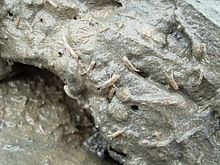- Corophium volutator
-
Corophium volutator Scientific classification Kingdom: Animalia Phylum: Arthropoda Subphylum: Crustacea Class: Malacostraca Order: Amphipoda Family: Corophiidae Genus: Corophium Species: C. volutator Binomial name Corophium volutator
(Pallas, 1766)Synonyms [1] - Oniscus volutator Pallas, 1766
- Corophium grossipes Templeton, 1836
- Corophium longicorne White, 1847
Corophium volutator, one of several organisms called mud shrimp, is a small (up to 10 millimetres or 0.4 inches long) amphipod of the family Corophiidae.[1]
It inhabits the upper layers of sand on the coasts of the Netherlands, Germany, the United Kingdom and France, as well as in the Bay of Fundy on the coasts of Nova Scotia and New Brunswick.
Like most amphipods, C. volutator feeds on plankton. At high tide, it produces a current with its slightly elongated hind legs, to make the water flow through its tube. On low tide, it scratches along the surface with its elongated second pair of antennae, producing star-like patterns.
The silk-lined U-shaped tubes reach about 3 cm deep in summer, and up to 12 cm in winter, to escape the freezing point. The tubes have a diameter of about 2 mm. When travelling, C. volutator produces patterns similar to a zipper.
The species lives up to a year, and produces up to three generations during its lifetime. The females brood the eggs inside their brood pouch or marsupium.[2] They are resistant to significant fluctuations in salinity.
They can occur in huge quantities: up to 60,000 per m2 have been observed.[2] This makes them an important part of the food chain.
The specific epithet volutator comes from the Latin volutare, meaning "to wallow".
References
- ^ a b M. J. de Kluijver & S. S. Ingalsuo (1999). Macrobenthos of the North Sea. http://ip30.eti.uva.nl/bis/crustacea.php?selected=beschrijving&menuentry=soorten&id=303.
- ^ a b J. A. Percy (1999). "Master of the Mudflats". Bay of Fundy Ecosystem Partnership. http://www.bofep.org/corophiu.htm.
Categories:- Gammaridea
- Crustaceans of the Atlantic Ocean
- Animals described in 1766
Wikimedia Foundation. 2010.

